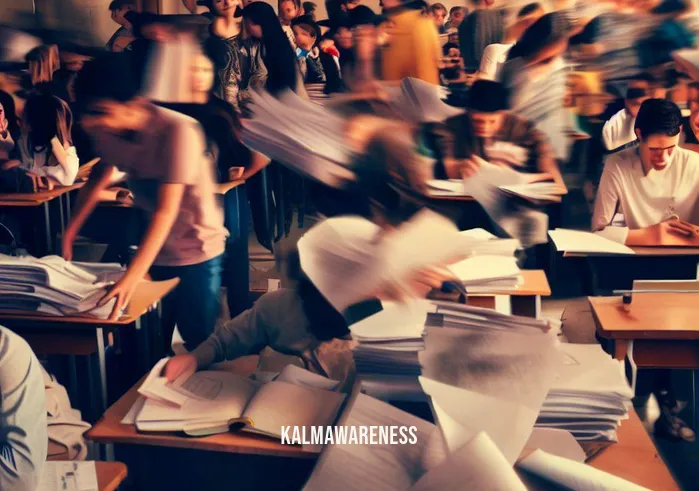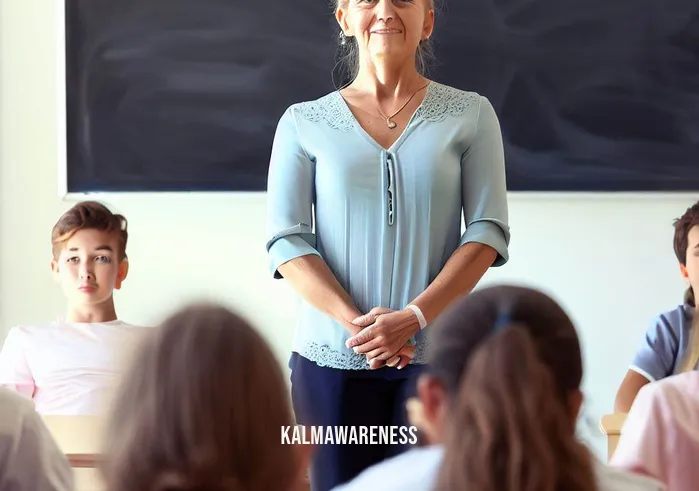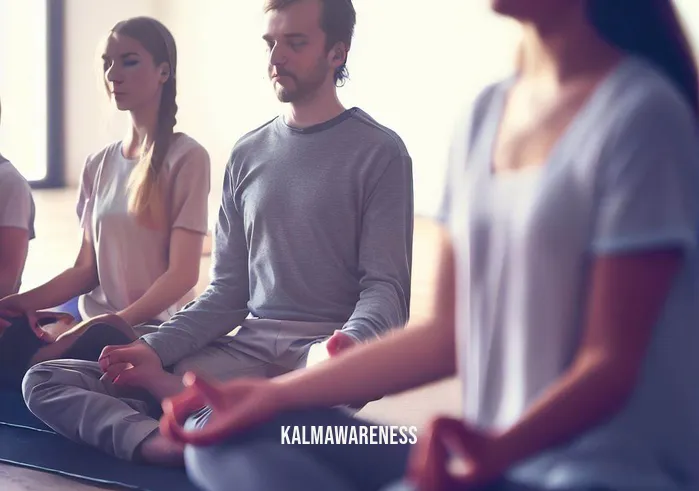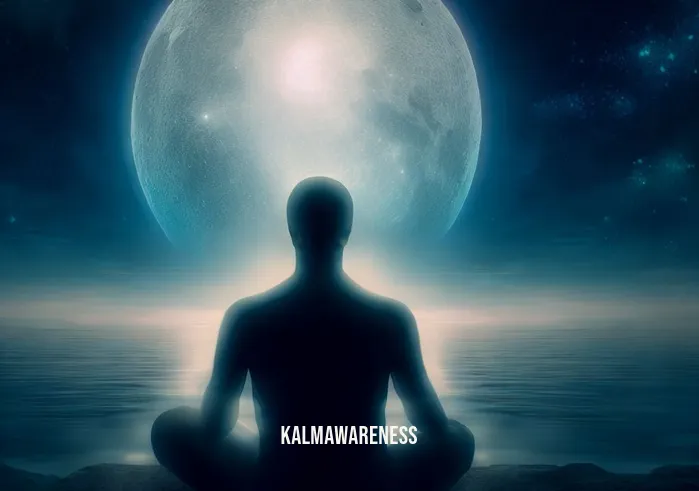Calm Classroom Body Scan: The Foundation of Mindfulness in Education
The modern classroom is a bustling hub of activities, digital distractions, and heightened emotions, often culminating in an environment that’s antithetical to effective learning and student well-being. Teachers and education professionals are consistently seeking ways to enrich the classroom atmosphere, encouraging relaxation, focus, and a conducive learning environment. One increasingly popular technique coming into the limelight is the calm classroom body scan. A derivative of mindfulness practices and closely related to breathing and meditation, this method has promising potential for transformative change. This is the first segment of a five-part essay, aiming to guide educators and parents alike on the merits and methods of implementing a calm classroom body scan.
Why the Need for Calm Classroom Body Scan?
Growing Challenges in Education
Education is no longer just about rote learning or meeting curricular milestones; it also encompasses the holistic development of children. Amidst academic pressures and the blurring lines between study and personal time due to the prevalence of online learning, students often find themselves stressed, unable to relax and be aware of their emotional well-being.
Mindfulness: A Focused Approach
Addressing these concerns, mindfulness in education has emerged as an essential pedagogical tool. It diverges from the debate of which is better: mindfulness or multitasking, siding overwhelmingly in favor of a focused approach to learning and living. Mindfulness techniques can involve everything from hand yoga poses to complex meditation protocols like EMDR meditation. However, the practice of a calm classroom body scan serves as an accessible entry point to these mindful practices.
How Does it Work?
The Mechanism Behind the Method
A body scan typically involves attaining a peaceful state of mind by focusing one’s attention sequentially on different parts of the body. From the tip of the toes to the top of the head, each body part is mentally examined and relaxed, essentially conducting a ‘scan.’
“The scan is not just an exercise in relaxation; it’s a methodical way to cultivate awareness of the present moment and mitigate emotional turmoil.”
Complementary Techniques
For those who are already invested in different mindful practices, the body scan can serve as a complimentary routine. Whether it is about enhancing the mindful movement in sleep or using the H.U.G. Method for shifting your emotional state, integrating a body scan can significantly enhance the overall experience.
Unpacking the Benefits
- Increased Focus: The practice obliges students to direct their attention inward, in doing so, it inherently develops focused minds.
- Emotional Regulation: Being mindful of bodily sensations helps to recognize emotional states, providing a new avenue for kid calm.
- Stress Reduction: The process diminishes anxiety by anchoring the mind, steering it away from future worries or past regrets.
The first step towards implementation is a willingness to adopt new strategies. From there, the realm of mindfulness opens up diverse opportunities. Even if you’re skeptical about whether these practices will work in an academic setting, remember: if practice makes perfect, then experimenting with these techniques is an educational exercise in itself.
As we delve deeper into the topic, the next segment will guide you through practical steps for successfully conducting a calm classroom body scan, from preparation to execution and feedback. Whether you’re an educator, parent, or student, these insights are designed to equip you with the tools needed for a balanced and mindful educational journey.
Proceed to Segment 2 for a step-by-step guide on implementing a Calm Classroom Body Scan.

Implementing Calm Classroom Body Scan: A Practical Guide
Having established the imperative need for mindfulness in education and the unique advantages offered by calm classroom body scans, it’s time to turn theory into practice. Implementing a body scan meditation doesn’t need to be complicated, but it does require some thought, preparation, and a bit of creativity. This segment will provide you with a practical guide to integrating this relaxation technique into your classroom, complete with lists and a comprehensive table for clarity.
Components of a Calm Classroom Body Scan
Structuring the Exercise
Start Simple: Begin by asking the students to sit in a comfortable position. Ensure they are relaxed but alert. This prepares them for the floating meditation experience that follows.
Prompting: Use a gentle, soft-spoken voice to guide the students through the process. Remind them to keep in mind the definition of mindfulness, which is being fully present.
Duration: The entire exercise shouldn’t take more than 5-10 minutes, ideal for quick but effective meditations.
Essential Props
- Timer: To keep track of time and ensure the exercise doesn’t stretch too long.
- Background Music: Soft instrumental music can add to the relaxation.
- Instructional Cards: These can contain reminders to touch that body part which is being focused on.
Execution and Monitoring
Instructions: Begin from the toes, moving upwards. Ask the students to focus on each body part and imagine it relaxing.
Guidance: Occasionally remind students to keep their movements relaxed as they scan through their body.
Debriefing: Once the session ends, encourage students to share their experience. This can help them cultivate mindfulness in a deeper sense.
Comparative Table: Calm Classroom Body Scan vs. Other Techniques
| Technique | Time Required | Equipment Needed | Benefits | Skill Level |
|---|---|---|---|---|
| Body Scan | 5-10 minutes | Timer, Instructional Cards | Increased focus, emotional regulation, stress reduction | Beginner |
| EMDR Meditation | 20-30 minutes | EMDR device, professional guidance | Trauma healing, emotional stability | Advanced |
| Hand Yoga | 10 minutes | None | Improved flexibility, stress relief | Intermediate |
| Floating Meditation | 30-60 minutes | Floating pod, professional guidance | Deep relaxation, heightened sensory awareness | Advanced |
| Quick Meditation | 2-5 minutes | None | Quick relaxation, improved mood | Beginner |
Why Choose Calm Classroom Body Scan Over Others?
The table above clearly delineates why the body scan technique is particularly beneficial in a classroom setting. It’s quick, easy to guide, requires minimal resources, and is particularly effective for those who are new to the concept of mindfulness. Moreover, the exercise is versatile; you can conduct it while students are lying down or in a more traditional sitting posture.
What’s Next?
Now that we’ve covered the practical aspects of conducting a calm classroom body scan, our next segment will focus on how to overcome common challenges that might arise during implementation. We’ll also delve into advanced techniques to elevate the effectiveness of your body scan sessions.
Stay tuned for Chapter 3, where we will discuss overcoming hurdles and mastering the art of calm classroom body scans.

The Transformative Power of Calm Classroom Body Scan: Stories of Hope and Inspiration
As we advance in our exploration of mindfulness in education, specifically through the lens of the calm classroom body scan, it’s essential to anchor ourselves in the human stories that breathe life into these techniques. In this chapter, we shall delve into inspirational accounts and powerful quotes that testify to the transformative effects of body scans in educational settings.
Real-World Success Stories: Calm Classroom Body Scan
Educators across the world have been increasingly incorporating mindfulness and body scanning exercises into their curricula. The impacts range from an improvement in focused minds to a significant decline in classroom disruptions. These are not just numbers or statistics; these are narratives of hope.
“Your value does not decrease based on someone’s inability to see your worth.”
— Unknown
This quote reflects the core of what a calm classroom body scan—or tranquility scan, as some call it—can achieve. By helping students focus on their inner self, they learn to value themselves beyond external judgements.
Moving Beyond ADHD
One such example involves a teacher who specialized in dealing with children with ADHD. After implementing regular body scan sessions, the teacher noted not just an academic improvement but also a decline in impulsive behaviors among the students.
“The real voyage of discovery consists not in seeking new landscapes, but in having new eyes.”
— Marcel Proust
The process is akin to the mindfulness prescription for adult ADHD, repurposed for a younger audience. This story serves as a beacon of hope that innovative approaches to common challenges can yield unexpected, positive results.
Why is this Relevant to You?
The effectiveness of calm classroom body scans cannot be overstated, especially in a world where students are constantly juggling between academics, extracurricular activities, and social life. Mindful body scanning can help them find their center amidst the chaos.
“Mindfulness isn’t difficult; we just need to remember to do it.”
— Sharon Salzberg
Whether you’re an educator striving to cultivate a conducive learning environment, or a student aiming for emotional and academic balance, the calm classroom body scan is a versatile tool that has shown promise in a variety of settings.
Bridging the Gap Between Teachers and Students
Another inspirational account comes from a high school in an urban setting, dealing with high crime rates and frequent classroom disruptions. Here, the calm classroom body scan acted as an icebreaker between students and teachers. Within weeks, educators observed a shift towards a peaceful state of mind among the students, who seemed more receptive and less agitated.
“In the end, we will remember not the words of our enemies, but the silence of our friends.”
— Martin Luther King Jr.
In this context, the silence refers to mindful silence, a silence that promotes understanding, compassion, and deep learning.
What Lies Ahead
These stories and quotes are not just stand-alone instances; they serve as the stepping stones to a larger transformation that is taking place in classrooms globally. They underline the feasibility and relevance of integrating calm classroom body scan techniques into mainstream education.
As we look forward to our next chapter, we will dive into the science behind these transformative effects. What are the neurobiological changes that occur during a body scan? How do they translate into visible behavioral shifts? And most importantly, how can we optimize the calm classroom body scan to tailor it for diverse educational environments?
Continue to Chapter 4, as we demystify the science behind the transformative power of calm classroom body scans.

The Anatomy of Calm Classroom Body Scan: A Closer Look
After journeying through the landscape of hope and inspiration that the calm classroom body scan provides, it’s time to dissect the mechanics of this powerful tool. This chapter will offer an in-depth exploration using bullet points and lists, answering questions about the ‘how’ and ‘why’ behind the body scan’s effectiveness in the classroom.
The Physiology of Mindfulness: Unveiling the Secrets
Before we delve into the specifics, let’s look at the larger umbrella under which the calm classroom body scan falls: mindfulness. Understanding the physiological changes induced by mindfulness activities can give us insights into the body scan’s efficacy.
Bullet Points on Physiological Changes During Mindfulness:
- Brain Activity: Increased activity in the prefrontal cortex, responsible for decision-making and social behavior.
- Cortisol Levels: A decrease in cortisol levels, often linked with lower stress.
- Heart Rate: A more steady and calmer heart rate, conducive for focus.
- Oxygen Consumption: Lowered rates, which often correlates with a state of relaxation.
“A moment of self-compassion can change your entire day. A string of such moments can change the course of your life.”
— Christopher Germer
Much like the hand yoga poses that focus on specific pressure points to induce relaxation, calm classroom body scans focus on different body parts sequentially to bring about overall well-being.
Components of a Calm Classroom Body Scan
Now that we know the overarching benefits, let’s dive deeper into the essential components of a body scan, often called “awareness scan” or “tranquility scan” in some educational circles.
Essential Components
- Guided Narration: Often a teacher or a recorded voice serves as a guide.
- Sequential Focus: The guidance involves focusing on one body part at a time.
- Breathing: Involves taking slow, deep breaths, similar to a brief meditation on breath.
- Time: Typically lasts between 5 to 20 minutes, depending on the age group and setting.
- Feedback: Post-session discussions can be beneficial for gauging effectiveness.
By integrating these elements, a calm classroom body scan can effectively promote student well-being and relaxation while enhancing focused minds.
Advantages Over Other Techniques
Mindfulness in education is a vast field with diverse techniques. How does a calm classroom body scan compare with other approaches?
- Universality: Unlike some techniques that require prior knowledge or physical agility, body scans are accessible to everyone.
- Quick Results: The calming effect is often immediate, unlike more prolonged practices such as floating meditation.
- No Special Equipment: No need for special cushions, music, or attire. This simplicity makes it perfect for classroom settings.
“The best way to capture moments is to pay attention. This is how we cultivate mindfulness.”
— Jon Kabat-Zinn
The body scan stands out as a straightforward yet highly effective tool in promoting relaxation and awareness in a learning environment.
The Road Ahead
Having examined the anatomy of calm classroom body scans, our understanding of this remarkable technique is now more nuanced and in-depth. The next chapter will serve as a culmination of our journey, providing you with actionable steps and protocols to implement this powerful tool in your classroom settings.
Are you excited to put theory into practice? Stay tuned for the final chapter where we offer a practical guide to incorporating calm classroom body scans into your educational routine.

Embarking on a Journey of Awareness: Final Thoughts on Calm Classroom Body Scan
We’ve journeyed together through the ins and outs of calm classroom body scan, also referred to as “relaxed classroom awareness” or “focused student relaxation.” From understanding the nuances to dissecting its components and appreciating its unmatched benefits, we have unraveled how this simple yet impactful practice can change the atmosphere of classrooms and contribute to student well-being. Now, let’s take a moment to look back and forward—reflecting on the journey undertaken and envisioning the road ahead.
Moments of Mindful Reflection
This journey began with an introduction to the calm classroom body scan—a mindfulness technique that promotes tranquility, focus, and a conducive learning environment. Throughout this exploration, we’ve peeked into the mindfulness prescription for adult ADHD and even explored the practicality of engaging in meditation in different contexts like lying down.
“Do not dwell in the past, do not dream of the future, concentrate the mind on the present moment.”
— Buddha
From the physiological changes to practical components and inspirational insights, we’ve learned that the body scan is far more than a fleeting classroom trend. It’s a foundational practice that can serve students for years to come, much like other methods that involve attaining a peaceful state of mind.
Envisioning Tomorrow’s Classrooms
Imagine classrooms of the future, where students don’t just learn about history, science, or mathematics, but also about themselves. Imagine a world where the young minds are not just filled with facts but are also trained to be aware, calm, and focused. This is the kind of future that practices like calm classroom body scans can help create. A future where mental health and emotional well-being are not footnotes but essential chapters in every student’s educational journey.
“Your work is to discover your work and then, with all your heart, to give yourself to it.”
— Buddha
Your Next Steps: A Call to Action
Intrigued? Inspired? Then, don’t let this be the end of your journey. This calm classroom body scan is a starting point—a pilot test for what could be a transformative educational experience. To continue this exploration, why not revisit our segments on EMDR meditation or mindful movements for sleep for more in-depth understanding?
A Heartfelt Thank You
Your time and interest in this topic signify the willingness to take an educational paradigm shift seriously. We’re thrilled you took this journey with us. Stay tuned for more enlightening content in future editions. From practices that engage your entire self like hug-method shifting to more specialized techniques, we’ve got an enriching roadmap ahead.
“Your greatness is not what you have, it’s what you give.”
— Anonymous
So go ahead, make calm classroom body scans a part of your daily educational routine. Share your stories of transformation, both as a teacher and as a student. And remember, the journey to mindfulness is a marathon, not a sprint. It’s the sum of little moments of awareness that leads to a lifetime of well-being.
Until our next journey together, keep in mind the limitless possibilities that come with awareness and focus. Thank you for reading, and we look forward to engaging with you in our future explorations!





